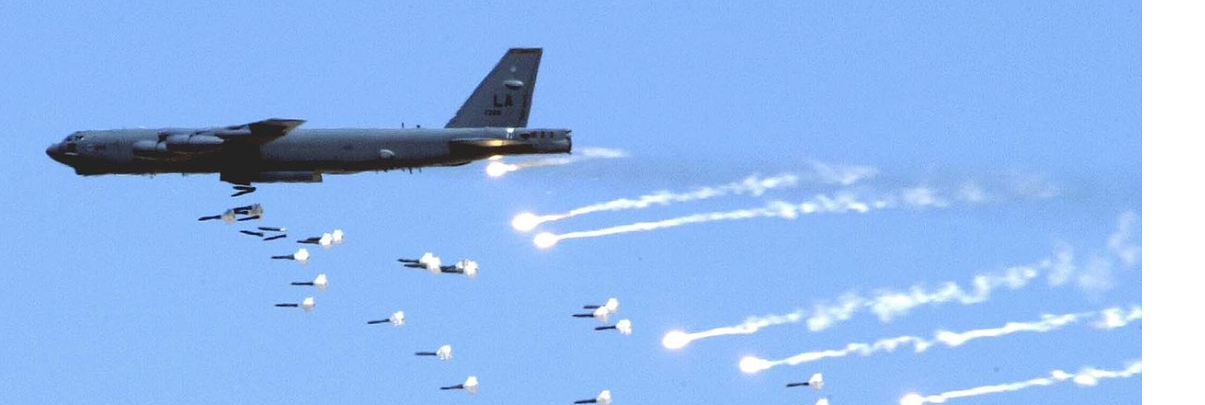700,000 Tons of Ordnance: The B-52 Stratofortress’s Performance at Tora Bora

Operating in 72-hour non-stop cycles, the B-52’s involvement at the Battle of Tora Bora peaked during its most intense phase.
“Our prayers were not answered. Times are dire and bad. We did not get support from the apostates who are our brothers. I’m sorry for bringing you here. It is okay to surrender,” crackled Osama bin Laden’s voice across the radio at the Battle of Tora Bora. The al Qaeda ringleader was lamenting what he believed to have been a grave strategic mistake at that time on December 16, 2001 in the White Mountains of Tora Bora, Afghanistan: the mistake of striking the United States on September 11.

The reason bin Laden was making what he believed were his final goodbyes was due to the fact that, at the behest of CIA and DELTA Force operators on the ground at Tora Bora, B-52 Stratofortress long-range bombers had unleashed the mother of all airstrikes on his suspected location.
Ladies and Gentlemen, We (Almost) Got Him
Once the CIA had triangulated bin Laden’s position from his radio signals, the B-52s came flying overhead, dumping BLU-82 15,000-pound bombs over Tora Bora. Bin Laden himself is believed to have been wounded in the shoulder by shrapnel from one of those American bombs. Few believed that he could have possibly survived the ordeal at Tora Bora. Sadly, of course, he did survive—popping up in a propaganda video shortly after the bombings, showing him bandaged and wounded but still alive.
Shortly after the terrorist attacks of September 11, 2001, the Bush administration launched Operation Enduring Freedom (OEF) in Afghanistan, aimed at capturing or killing bin Laden and other al Qaeda members and overthrowing the Taliban regime that sheltered them. By late November 2001, intelligence had pinpointed bin Laden at Tora Bora, a labyrinthine cave complex spanning 25 square miles, fortified with bunkers, tunnels, and anti-aircraft guns. US Special Forces, CIA, and Afghan Northern Alliance militias, launched a ground assault. The terrain—towering peaks over 14,000 feet and narrow valleys—posed immense challenges for infantry.
Enter US airpower: a relentless campaign that ultimately dropped an astonishing 700,000 tons of ordnance in just four days, from December 4 through December 7. The B-52 Stratofortress, with its ability to loiter for hours and deliver massive payloads, became the backbone of this strategy.
Nicknamed the Big Ugly Fat Fellow (BUFF), the B-52 Stratofortress first entered service when Harry S. Truman was president of the United States, at the dawn of the Cold War. Capable of flying a subsonic speed up to 50,000 feet, it boasts an unrefueled range exceeding 8,800 miles, allowing sorties from distant bases, like Diego Garcia, in the Indian Ocean. In Tora Bora, B-52s carried a mix of munitions: precision-guided Joint Direct Attack Munitions (JDAMs) accurate to within 10-15 meters, laser-guided bombs, and the aforementioned 15,000-pound BLU-82 “Daisy Cutter,” a massive fuel-air explosive first designed to clear helicopter landing zones in the Vietnam War but repurposed for psychological terror.
B-52s could unleash up to 70,000 pounds of bombs per mission, turning mountainsides into craters and sealing cave entrances.
The B-52 Shined During the Battle of Tora Bora
Operating in 72-hour non-stop cycles, the B-52’s involvement at the Battle of Tora Bora peaked during its most intense phase. The B-52s conducted carpet bombing runs that illuminated the night sky with explosions, targeting al Qaeda positions and supply lines. The strikes reportedly hit Bin Laden’s location at least twice, dispersing fighters and destroying formations.
Afghan militias, bolstered by this air umbrella, captured 52 prisoners, mostly Arab fighters in al Qaeda. More than 100 more were later captured fleeing to Pakistan.
The B-52’s loitering capability provided the perennial air support the DELTA Force local Afghan militias needed to keep pressing the fleeing al Qaeda and Taliban fighters.
 The B-52 Stratofortress’s firepower was undeniably effective, killing an estimated 250-500 al Qaeda defenders and eroding their morale. Yet, controversies loom large. A 2009 Senate report lambasted the overreliance on airpower, including B-52 operations, arguing that the decision to deploy fewer than 100 US troops—versus the recommended 3,000—to Tora Bora ultimately allowed bin Laden to slip through America’s fingers and escape to Pakistan’s tribal areas.
The B-52 Stratofortress’s firepower was undeniably effective, killing an estimated 250-500 al Qaeda defenders and eroding their morale. Yet, controversies loom large. A 2009 Senate report lambasted the overreliance on airpower, including B-52 operations, arguing that the decision to deploy fewer than 100 US troops—versus the recommended 3,000—to Tora Bora ultimately allowed bin Laden to slip through America’s fingers and escape to Pakistan’s tribal areas.Critics contend that this “light footprint” strategy, prioritizing B-52 strikes over ground encirclement, ultimately prolonged the Afghan insurgency and emboldened global terrorism. The humanitarian consequences were also notable; the B-52’s cluster bombs drew fire for high dud rates and later risks to civilians, though their use in the relatively remote terrain of Tora Bora minimized collateral damage.
The Battle of Tora Bora, illuminated by the iconic B-52’s fiery salvos, encapsulated the promise and pitfalls of 21st century warfare. While it decimated al Qaeda’s stronghold, the failure to ultimately capture Osama bin Laden at this crucial juncture—letting him direct the war against the Americans for another decade until his killing in Abbottabad, Pakistan—haunts US military doctrine. Today, the B-52 continues missions worldwide, Tora Bora reminds military planners of air power’s limits in unforgiving landscapes.
- Questions and Answers
- Opinion
- Motivational and Inspiring Story
- Technology
- Live and Let live
- Focus
- Geopolitics
- Military-Arms/Equipment
- Segurança
- Economy/Economic
- Beasts of Nations
- Machine Tools-The “Mother Industry”
- Art
- Causes
- Crafts
- Dance
- Drinks
- Film/Movie
- Fitness
- Food
- Jogos
- Gardening
- Health
- Início
- Literature
- Music
- Networking
- Outro
- Party
- Religion
- Shopping
- Sports
- Theater
- Health and Wellness
- News
- Culture

